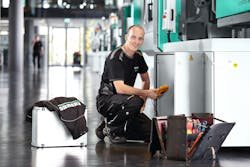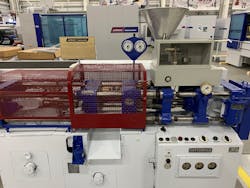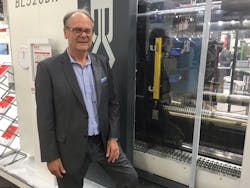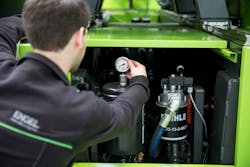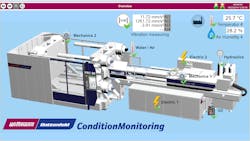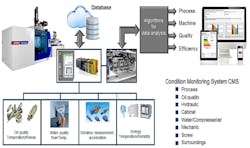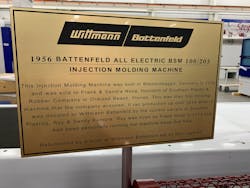Faithful care protects machines, bottom line
By Karen Hanna
Drive down any neighborhood street on a beautiful summer day, and you’ll see them: the car pamperers, armed with chamois and hose. But on any freeway, you’ll see just the opposite, as well: cars with duct-taped bumpers, loud exhaust and one light out.
The range of maintenance devotion among injection molders is no different, from the outliers that let their machines run till failure to those with presses that are older than some employees. Most common, industry insiders said, are companies that land somewhere in the middle; their operators might not be able to check their reflection on the sides of the presses, but they do keep them running.
It’s only good business sense, said Bill Duff, GM of sales and marketing for Yizumi-HPM.
“You own a car and most everybody has a vehicle and if you don’t take care of it, like changing the oil, rotating the tires, if you don’t do anything for it ... changing the brake pads, it won’t run for you long-term,” he said.
In it for the long haul
Productive machine users realize that the time and expense saved in skimping on maintenance carry a high price down the road. To the experts, maintenance should be routinized, to allow personnel to keep their machines running, rather than forcing them to react to a major equipment failure.
Processors like Ray Komara can testify to that. He has made a career in plastics, and he’s worked with machines that have every bit as much experience.
“The key to me — I’ve been doing this for 46 years — the key is when you see a problem, fix it when it’s little,” said Komara, the owner of Southern Plastics and Rubber Co., which recently retired two well-loved machines. The Ormond Beach, Fla., company’s 1956 Battenfeld BSM All-Electric 100/205 press, which it bought as a used machine in 1970, now is a showpiece at Wittmann Battenfeld’s Torrington, Conn., headquarters.
“I believe we could have had it running still, but the safety standards just aren’t up to modern requirements,” said David Sharp, operations manager for Wittmann Battenfeld’s injection molding machines.
Other than a broken shaft, Komara said the German-made, Sputnik-era press was in working order. It’s made everything from youth football pads to stakes used to identify plants.
Wittmann Battenfeld spiffed up the machine and gave it a marker paying tribute to the seven different decades it ran.
“That was quite a little gem,” Komara said.
Getting to know your machine
Taking care of an injection molding machine doesn’t have to mean losing significant chunks of operating hours, and much of the task can be fairly rote — following the manual, taking guidance from the manufacturer and staying on schedule. It begins on Day 1 of ownership and continues throughout the machine’s life.
According to Sharratt, who has visited about 4,000 injection molding facilities over a 40-plus-year career, keeping ahead of the game takes mere hours. He said operators or maintenance personnel should dedicate four or five hours every three months to perform machine checkups, giving the equipment a short break from the daily grind of constant operations. Once a year, he advises committing a full day to a machine’s maintenance.
Routine maintenance can usually be done within a shift, Yizumi-HPM’s Duff said. A 100-point check of a 300-ton machine — recommended after the machine’s first 1,000 operating hours and every 2,500 hours after that — might take six hours.
The first step comes before a machine is ever installed, according to Arburg’s Mattes. “When buying a new machine,” he said, “make sure that it is equipped with modern features which reduce or evenOnce installed, users can benefit from their OEMs’ expertise, as well as their machines’ control systems, which can guide them through what needs to be done and when. The systems also help users manage their inventory of parts.
Harald Wegerer, VP of Engel’s customer-service division, acknowledged that “reading a documentation is nothing you can excite an engineer with.” But it’s important because “knowing all relevant features and properly using them in your production is the basis to get the best possible results from your investment.”
Manuals and control systems prescribe a maintenance calendar. Alfred Rak, the president and CEO of Bole Machinery, and others suggested that people follow it.
“There is a checklist that you have to work daily, weekly, monthly, quarterly, and we have worked out the checklists not for fun, but they are to be used,” Rak said.
Familiarity with a machine reaps benefits throughout the machine’s life. “The deeper the understanding of your machine’s operation and control system, the more productivity you will gain from the machine,” Sharratt said.
On-board diagnostics are another important guide.
For example, Mattes said Arburg’s Allrounders feature the Selogica control system, which provides reminders when maintenance is needed for the press, molds and auxiliary equipment. It also tracks when the work is done, he said.
“This ensures that maintenance work is clearly traceable, and that evidence of the work can be provided in the event of audits and certification processes,” he said.
Similarly, Wittmann Battenfeld offers its Condition Monitoring System, which monitors features such as servo motors, hydraulic fluid and the machine’s pneumatic and mechanical systems. By monitoring screw vibration, for example, it can identify when a screw needs to be looked at. “This helps the customer know when they should be ordering a new screw or sending one out for repair. It helps the customer prepare for this major maintenance, reducing their downtime by having parts in stock and being able to switch production to another machine if need be,” Sharp said.
Taking advantage of OEMs’ expertise
In addition to manuals and on-board maintenance systems, OEMs offer programs, including service contracts, to help users care for their machines. Yizumi-HPM, for example, sends technicians to set up machines and check them over once new users have had a chance to break them in.
“New machine customers, they get a machine, we install it, we check it, we train them,” Duff said. “Six months later, we go back and do the routine maintenance on the machine.” Yizumi-HPM has only one requirement for customers interested in availing themselves of the service: They must be sure their own maintenance personnel are on hand as well, to pick up pointers.
The program has multiple purposes. Obviously, it benefits customers new to Yizumi-HPM machines, but Duff said there’s another advantage. By training its customers in the right way to operate and maintain their machines, Yizumi-HPM heads off possible problems that might result in costly warranty claims.
In addition, the company provides all new machine owners with a maintenance kit, complete with the accessories, like filters, that will need to be regularly replaced.
In the midst of unprecedented economic upheaval, Bole, too, is looking to help customers learn how to make their investments last.
To help plants over the last few months, as the world has confronted the twin economic and health crises related to COVID-19, the company has dispatched its maintenance experts to plants throughout the country, to check in on customers and their machines. As of mid-September, they had visited sites operating more than 80 percent of the Bole machines in the U.S.
The courtesy inspections are one way for plants to derive some benefit from the last few months and maintain the value of machines in the field.
“Most of them have reduced workloads, and it’s a good time to run the maintenance,” Rak said.
“Those customers who were already online with our remote service tool e-connect.24 had a huge advantage and did not need to panic if they could still get all support required to optimize and run production,” he said.
He also touted the company’s training centers. He admitted it’s perplexing to see machine users invest in equipment but scrimp on training.
“Our engineers know these challenges from their daily business and can for sure also help you to become even better in what you are doing,” Wegerer said.
The nuts and bolts of hydraulics
OEM representatives emphasized some specific key aspects to monitor, including mechanical and electrical components, process consistency and safety features. Duff stressed making sure that machines are inspected regularly for parallelism.
“The machine has to be on good footing,” he said.
But, when it comes to machine life, nothing matters more than maintaining hydraulic systems in the presses that have them, said Jason Canale, national service manager for Boy Machines.
Oil is the essential fluid in the circulatory system of any hydraulic machine, and a top-line item for any maintenance checklist.
“In 70 to 90 percent of cases, damage to hydraulic components is attributable to contamination in the hydraulic system,” Arburg’s Mattes said. “Oil management is a preventive measure which preserves the availability and reliability of Allrounder injection molding machines in the long term.”
Machine users should consult with their OEMs regarding proper oil temperature and check the oil condition regularly. Exact maintenance tips vary by OEM.
According to Canale, maintenance personnel should analyze their Boy machines’ oil every 5,000 operating hours by taking oil from the bottom of the reservoir; this is especially critical if the oil is running hot. They should replace — rather than try to clean — the high-pressure oil filter every 5,000 hours, he said.
Changing the oil regularly — about every 20,000 operating hours — increases the life expectancy of the pump, valve and seal, Canale said.
In addition, he said maintenance personnel should check the oil reservoir breather filter at least once a year for blockage to prevent the oil reservoir from being pressurized.
“Do not ignore strange sounds from the hydraulics which could indicate aeration of the oil which can cause hydraulic component or hydraulic seal failure, hydraulic hose failure and inconsistent machine movements from air in the cylinders,” he said.
Like Canale, other OEM representatives advised users to quickly identify and address the causes of noises, or other deviations from normal operating conditions.
Hoses should be checked on a weekly basis for weak spots, crimps and leaks, Absolute Haitian’s Sharratt said. Leaks should be fixed at once.
To prevent pump and seal damage, Canale said machine users must immediately address coolant contamination or poor coolant flow.
Other systems to monitor
In addition to watching over hydraulic systems, maintenance personnel need to keep an eye on mechanical and electrical components, process consistency and safety features.
Just as oil is fundamental to the hydraulics, lubrication keeps the mechanical systems running smoothly. Shifting movements could be indicative of loose fixing nuts on tie bars or piston rods, so keeping fasteners tight is important.
Canale advised using an anti-seize compound on barrel components, such as the nozzle, screw tip and barrel cap bolts.
To protect electrical systems, Canale advised that users examine and clean the electrical panel cooling filters monthly and make sure that the cooling fan is operational. Just like other machine parts, the electrical components should be tight, and maintenance personnel should periodically check that wires and cables are properly seated. To help remove oxidation, they should use electrical contact cleaner on older machine control boards. To prevent damage to heater elements, Canale said maintenance personnel should slide barrelSharratt said personnel should check incoming power lines every quarter.
Process consistency is an important indicator of the maintenance status of a machine. Once a month, Canale said, maintenance personnel should perform a check-ring test using cushion. Additional necessary checks include examining the mechanical linear stroke transducer couplings for proper attachment to the fixed point; and comparing the voltage put out by heater thermocouples to the voltages indicated by applicable signal charts, available on the web. Workers also should ensure that thermocouples are making proper contact with the barrel steel; if they’re not, this area of the barrel will overheat, leaving evidence of damage in the adjacent heater zones.
In addition to the machine’s operating systems, safety is paramount, OEM representatives said. Companies said their personnel will not work on machines that have safety violations unless the job involves first fixing the safety issue. Arrangements that compromise safety protocols could jeopardize workers, as well as the OEMs’ warranties. They said machine users should perform a daily inspection of all safety devices. They should keep an eye out for damaged signal wires, switches and interlocks, and repair them immediately before returning a machine to operation.
To maximize the chances of catching a safety issue, Sharratt suggests training multiple people to do the walk-around.
“This is becoming an important consideration with more remote operation and automation and less hands-on awareness of the machines,” the Absolute Haitian manager said.
Breaking the mold
Care of a machine extends beyond maintenance schedules and on-board diagnostics. The knowledge and training of operators, as well as a plant’s environment, all play a role in a machine’s longevity.
Yizumi-HPM's Duff said, while most of his customers are diligent about machine maintenance, he’s seen machines damaged, through either neglect or ignorance. As an example, he recounted a visit a few years ago to a plant where a young engineer was struggling to keep the mold inside one press intact.
When Duff asked for details, the engineer told him, “Well, I keep cracking the cavities.” Turns out, he was running a tool meant for a 200-ton press on a brand-new 600-ton press.
“He was crushing the tool with the clamp and breaking the tool,” Duff said.
Fortunately, the machine and platen escaped unscathed, but Duff said pairing tooling that’s either too large or too small for the press is a common cause of damage.
“We can’t fix dumb; we don’t warranty that,” he said.
Another common cause of machine-destroying, warranty-voiding damage is improper cooling, which can harm the oil. Arburg’s Mattes said unfiltered cooling water can lead to damage and failure due to leaking seals. Over time, valves can also become clogged. Ultimately, he said, filtering “saves on costs and resources.”
One recent service call Duff recounted illustrates the dangers of bad water. He said his customer’s new press was overheating, but the origin of the problem wasn’t in the plant at all — it was with the plant’s neighbor, an industrial processor of silica.
Sand from next door was clogging the cooling system.
“We opened up this [heat] exchanger, and all this ... it looked like a beach in there,” Duff said.
Luckily, no irreparable harm was done.
Applying common sense, along with elbow grease
Whether the machine is new or old, there’s no magic in keeping it running; it takes effort.
“We have HPM machines that we get calls on that are 30 years old, and they don’t run for 30 years unless you take care of them,” Duff said.
OEM representatives added a slew of other common-sense tips.
Engel’s Wegerer advised against being caught off-guard and recommended that machine users develop a sense of the kinds of parts they need to keep on hand.
“Often, we are struggling with very stupid things such as not having the contact information of our 24/7 hotline available during the night shift,” he said.
Wittmann Battenfeld’s Sharp stressed cleanliness.
He said workers should be careful when removing lines during a mold change, to avoid making a mess. During purging procedures, they should avoid getting plastic on the machine, and remove it before it solidifies. In addition, they should keep the nozzle clean to prevent plastic from blowing back over heater bands and damaging them.
For manufacturers that commit to performing maintenance with diligence, the efforts pay off over the long run.
That’s what Komara has found in his career. As not all projects require the most advanced equipment or exceptionally fast cycle times, maintaining older machines is just good business for him. “Obviously, I’m not paying a bank every month, so that works for me,” he said.
The key to maintenance is doing the simple things. “As far as maintenance, we literally just kept it greased up,” he said. “And when we had a problem, we addressed it.”
Karen Hanna, associate editorFor more information:
Absolute Haitian, Parma, Ohio, 216-452-1000, www.absolutehaitian.com
Arburg Inc., Rocky Hill, Conn., 860-667-6500, www.arburg.com
Bole Machinery Inc., Stow, Ohio, 330-983-4700, http://boleamerica.com
Boy Machines Inc., Exton, Pa., 610-363-9121, www.boymachines.com
Engel Machinery Inc., York, Pa., 717-764-6818, www.engelglobal.com
Wittmann Battenfeld Inc., Torrington, Conn., 860-496-9603, www.wittmann-group.com
Yizumi-HPM Corp., Iberia, Ohio, 740-382-5600, www.yizumi-hpm.com